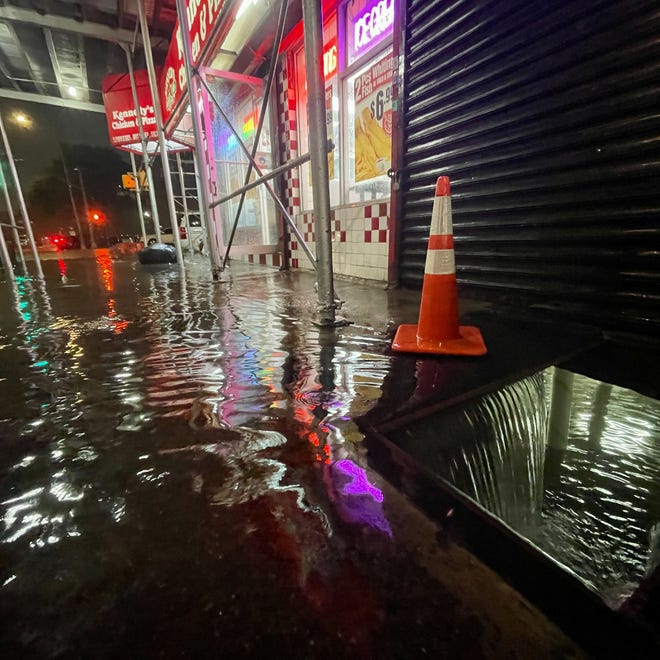
- Flooding is the most expensive natural disaster in the United States.
- "The ways and places in which we live are likely to continue to be impacted by our changing environment."
- The highest concentration of community flood risk is in Louisiana, Florida, Kentucky and West Virginia.
One-fourth of the United States' "critical" infrastructure is at risk of flooding, a new report released Monday morning warns.
The report pinpoints the nation's flood risk to critical infrastructure, such as utilities, airports, ports and emergency services like police, fire, and hospitals, in addition to residential properties, commercial properties, streets and local roads, and social infrastructure like schools and government buildings.
"Our work aims to determine the amount of flooding that would render infrastructure either inoperable or inaccessible," said Jeremy Porter of the First Street Foundation, which prepared the report.
First Street Foundation is a Brooklyn-based nonprofit research and technology group that works to define America’s flood risk.
What is going on with the weather? Tackle deep climate issues and current events with the Climate Point newsletter
In fact, according to the National Oceanic and Atmospheric Administration, flooding is the most expensive natural disaster in the United States and has cost the nation more than $1 trillion in inflation-adjusted dollars since 1980.
The report, titled "The Third National Flood Risk Assessment: Infrastructure on the Brink," took into account all types of floods, including slow-motion river flooding, fast-moving flash flooding, along with coastal flooding and storm surge from the ocean.
With an increasing number of flood events making headlines across the nation, there's now a greater awareness of the economic and human cost that flood-damaged infrastructure can create, report authors say.

"As we saw a few weeks ago following the devastation of Hurricane Ida, our nation’s infrastructure is not built to a standard that protects against the level of flood risk we face today, let alone how those risks will grow over the next 30 years as the climate changes," said Matthew Eby, founder and executive director of the First Street Foundation.
As the report notes, "The impact of Hurricane Ida stretched across the country, crippling the electrical grid in southern Louisiana, flooding the transportation infrastructure in the NYC metro area, and killing nearly 100 people. It is clear, now more than ever, that the ways and places in which we live are likely to continue to be impacted by our changing environment."
States and cities most at risk
According to the report, the highest concentration of community flood risk is in Louisiana, Florida, Kentucky and West Virginia, with 17 of the top 20 most at-risk counties in the U.S. residing in these four states. Louisiana alone accounts for 6 of the top 20 most at risk counties (parishes), and is home to the most at risk county in the U.S., Cameron Parish.
When shifting focus from counties to cites, a large percentage of the cities in the top 20 list is made up of cities from the states of Louisiana (three cities) and Florida (six cities). Among those cities, the major population centers of New Orleans (ranked 2nd); Miami (8th); St. Petersburg, Florida (12th); and Tampa (14th) all rank highly in the “most at risk” cities list.
Millions of Americans think they're safe from flood waters:They aren’t.
The report also found that risk to residential properties across the nation is expected to increase by 10% over the next 30 years, with 12.4 million properties at risk today and 13.6 million at risk of flooding in 2051.
Over the next 30 years, due to the impacts of climate change, an additional 1.2 million residential properties, 66,000 commercial properties, 63,000 miles of roads, 6,100 pieces of social infrastructure and 2,000 pieces of critical infrastructure will also have flood risk that would render them inoperable, inaccessible or impassable.
“This report highlights the cities and counties whose vital infrastructure are most
at risk today, and will help inform where investment dollars should flow in order to best mitigate against that risk,” Eby said.
Upgrading infrastructure can be expensive
Still, needed infrastructure upgrades can be expensive. But Matthew Kahn, a professor of economics at the University of Southern California who was not involved in the report, said high-risk flood zones without proper investment in flood prevention have hidden costs.
If an area gains a reputation for being susceptible to extreme climate events, people won’t buy homes and businesses won’t house their headquarters there, Kahn said.
“Those cities that prove to not be climate resilient – they’re going to be at a disadvantage,” he said. “They’re going to have brain drain.”
'I am living in a nightmare every day':What homeowners need to know as climate change threatens properties
Understanding which areas of the United States are prone to flooding will affect home buying trends and efforts homeowners make to protect their property: for example, adding stilts to a foundation or installing special sealants.
Those looking for a home have always taken location into account, considering factors like crime rates and local schools. But climate change risk is the newest factor in the home-buying equation, Kahn said.
A Bloomberg analysis of housing data in the U.S. between 2007 and 2017 found that average prices of homes in high-risk flood zones declined in value over the decade.
“You’re more likely to duck if you know the punch is coming,” Kahn said.
The complete First Street flood report can be accessed at this site.
Source link










